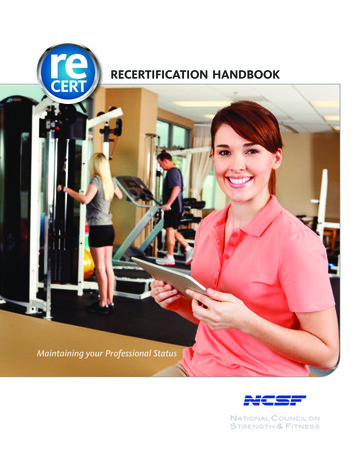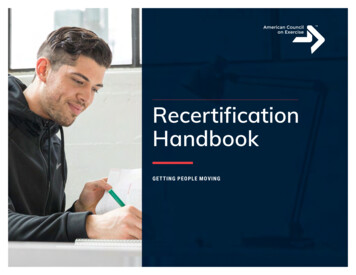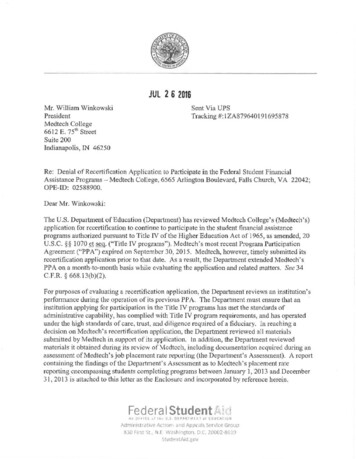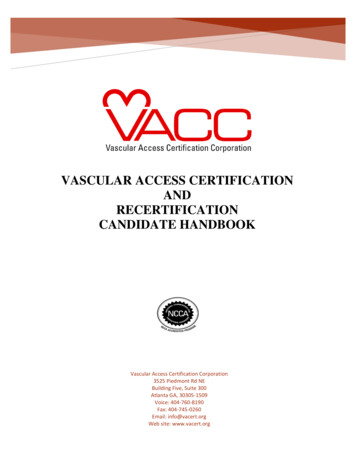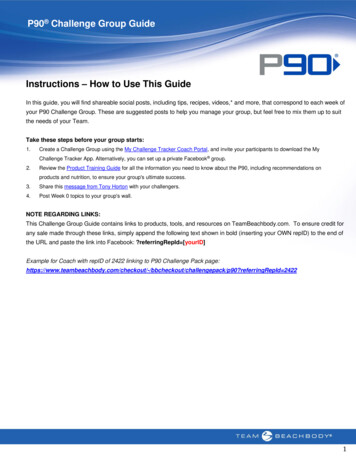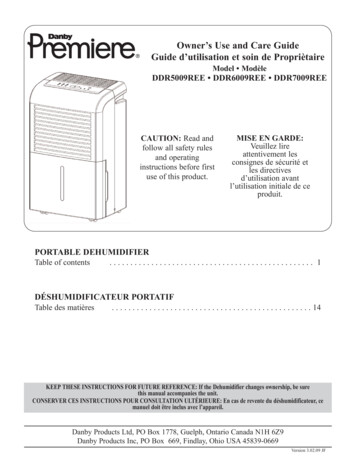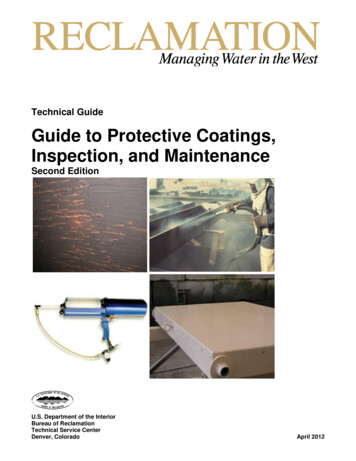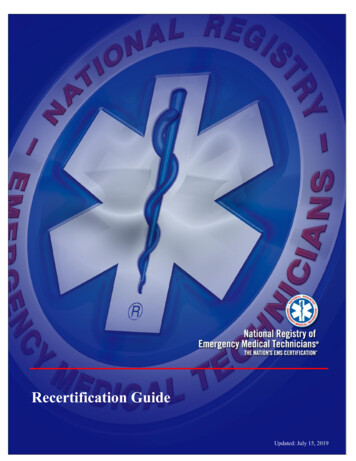
Transcription
Recertification GuideUpdated: July 15, 2019
COPYRIGHT 2019NATIONAL REGISTRY OF EMERGENCY MEDICAL TECHNICIANS, INC.6610 Busch BoulevardColumbus, OH 43229(614) 888-4484http://www.National Registry.orgAll Rights Reserved.COPYRIGHT WARNING:This manual is protected by Copyright laws of the United States of America. Only non-commercialreproduction of this material for educational purposes or the advancement of medical science is permitted. Nopart of this manual may be reproduced, stored in a retrieval system, or transmitted, in any form or by anymeans, electronic, mechanical, photocopying, recording, or by any other means whatsoever. Violators will besubject to prosecution and other actions.Suggested Citation: National Registry of Emergency Medical Technicians (2019). Recertification Guide.Retrieved from https://www.nremt.org
INTRODUCTIONThe vision of the National Registry of Emergency Medical Technicians CertificationTeam is to “provide customer support to Training Officers, Medical Directors, andproviders while validating that the EMS Professionals have maintained continuedcompetence through education and practice for quality patient care to ensure publicsafety.” Embracing this vision, it is the intent of the Certification Team to present thisguide to serve as a resource for agencies, training officers, medical directors, and otherstakeholders who may benefit.The National Registry is committed to the protection of the public by offering ongoingimprovements in the recertification process and updating requirements that willfavorably impact EMS for many years to come. Specifically, the National ContinuedCompetency Program incorporates the use of evidence-based medicine, gives state andlocal agencies the freedom to dictate a portion of their education requirements, andprovides a foundation for EMS professionals to embrace life-long learning.The National Registry of EMTs wishes to extend our sincere gratitude to the StateEMS Offices, Agencies, Training Officers, Medical Directors, and EMS Professionalswho are committed to maintenance of provider certification through the established
Table of ContentsBRIEF HISTORY OF NATIONAL EMS CONTINUED COMPETENCY . 5PRINCIPLES AND APPLICATION OF THE CONTINUED COMPETENCY PROGRAM . 5OVERVIEW OF THE NATIONAL CONTINUED COMPETENCY PROGRAM . 7NCCP Hour Requirements . 7NATIONAL COMPONENT . 8LOCAL COMPONENT. 10INDIVIDUAL COMPONENT . 11RECERTIFICATION METHODS . 12Recertification by Examination (RBE) . 12Continuing Education Method . 13STANDARDIZED COURSE GUIDE MAPPED TO NCCP TOPICS . 15ACTIVE AND INACTIVE CERTIFICATION STATUS . 16GENERAL CERTIFICATION POLICIES . 17ACCEPTABLE CONTINUING EDUCATION METHODOLOGIES. 20Explanation of Acceptable Education Methodologies . 20AVAILABLE RESOURCES AND HELPFUL INFORMATION . 23Training Officers. 23Physician Medical Directors . 23Individuals who are Recertifying . 23FREQUENTLY ASKED QUESTIONS . 24GLOSSARY. 26REFERENCES. 27
BRIEF HISTORY OF NATIONAL EMS CONTINUED COMPETENCYSince the registration of the first nationally certified EMS professional in 1971, EMS practice has evolvedsignificantly. Over the last four decades, the EMS profession has advanced from fundamental methods ofcare and transportation, to the delivery of more advanced emergency medicine in the out-of- hospitalenvironment. It is with the changes in the EMS Scope of Practice, the Practice Analysis, development andinclusion of evidence-based guidelines, and shifting community-based needs which helps drive theimportance of continued competency and maintenance of certification.The 2007 release of the National EMS Scope of Practice Model identified four levels of provider care: Emergency Medical ResponderEmergency Medical TechnicianAdvanced Emergency Medical TechnicianParamedicFurther, in 2009 the National EMS Education Standards were completed. These standards outlined educationnecessary to bring entry‐level providers to a competency level recognized in the National EMS Scope ofPractice Model.The National Registry utilized the Traditional Model of recertification since the 1980s when recertificationrequirements were based on the premise that all providers completed the same “clock hours” of training.While there was some flexibility to adapt some training to local needs, the recertification process did notprovide a formal pathway for adaptability. Refresher content areas did not prescribe training over areas ofpractice where significant change had occurred. Lastly, there was no ability for medical directors andsystems to focus training on needs identified by the continuous quality improvement process. As a result, theneed for a new, more contemporary model of recertification was created.PRINCIPLES AND APPLICATION OF THE CONTINUED COMPETENCY PROGRAMIn 2010, a task force met to consider revisions of the National Registry recertification process. The taskforce was a multi‐disciplinary group comprised of representatives of the major regulatory, medicaloversight and operational components of Emergency Medical Services.During the 2000’s continued competency was being addressed as a necessity for all medical specialties. Theongoing work of the American Board of Medical Specialties (ABMS) was reviewed by the task force. Insummary, the National Registry continued competency task force selected five key principles identified byABMS that were adopted and included in the recertification process for National EMS Certification.These 5 principles include:1.2.3.4.5.Professional StandingPractice PerformanceLife‐Long LearningIndividual Continuing EducationSelf-Assessment**Self-Assessment was originally adopted and included in the early stages of the NCCP recertificationmodel and is no longer required. 2019 National Registry of Emergency Medical Technicians, Inc., Columbus, OHAll materials subject to this copyright may be photocopied for the non-commercial purpose of educational or scientific advancement.5
1. Professional StandingFor an individual to hold National EMS Certification, the individual must not be barred fromlicensure/certification in any state. Holding a current valid license/certification is a critical element toassure the public that EMS providers have not faced any action that would bar them from practice.The National Registry requires disclosure of any criminal convictions or licensure/certification limitations aspart of the certification and recertification requirements.The National Registry has adopted a Criminal Conviction Policy to safeguard the public fromindividuals who, in practice as an EMS professional, might pose a danger to the public. All applicantsfor certification or recertification must disclose any criminal conviction as required on an application.The National Registry may deny an applicant eligibility to sit for a certification examination, denycertification, suspend or revoke an individual’s certification, or take other appropriate action with respectto the applicant’s certification or recertification based on an applicant’s felony criminal convictions and allother criminal convictions (whether felony or misdemeanor) relating to crimes involving physical assault,use of a dangerous weapon, sexual abuse or assault, abuse of children, the elderly or infirm and crimesagainst property, including robbery, burglary and felony theft.You may review further information related to this policy at nts/Criminal%20Convictions%20Policy Nov 2018.pdf2. Practice PerformanceEach EMS system across the nation has evolved to meet the individual needs of the community or regionit serves. National EMS Certification requires competency and education at the local level to best servespecific state and community needs. Continued competency to practice may be validated by psychomotoror skills assessments and other performance measurement tools. Validation of practice performance is theresponsibility of the provider’s EMS supervisor or training officer at the EMR and EMT levels andvalidated by the provider’s physician medical director at the Intermediate, AEMT and Paramedic levelsfor active certification.3. Life‐Long LearningInitial education/training is intended to provide entry-level knowledge and skills for an EMS provider.Building on the foundation of initial education, life-long learning aids providers in adapting to thecontinuous changes in patient care, education, protocols and other influencing factors of EMS practice.The improvement of patient care and providing quality care should be the goal of every EMS professionalregardless of location. Life-long learning is part of continued competency, therefore a requirement of theNational Continued Competency Program, and is a key component to an EMS professional’s career.4. Individual Continuing EducationA continuous competency program must focus on the entire clinical domain of out-of-hospital emergencycare. Continuing education focused on areas of need of the EMS professional has the potential to improveknowledge, better skills, and positively affect patient outcomes. Individual continuing educationembraces the principle of life-long learning. 2019 National Registry of Emergency Medical Technicians, Inc., Columbus, OHAll materials subject to this copyright may be photocopied for the non-commercial purpose of educational or scientific advancement.6
5. Self-Assessment (not currently utilized in NCCP)In the pilot phase of the new National Continued Competency Program, the National Registry launched alow-stakes self-assessment covering four broad domains of out-of-hospital emergency care to includeAirway, Respiration & Ventilation; Cardiology & Resuscitation; Medical, Obstetrics & Gynecology; andTrauma. Because this self-assessment was low-stakes and the culture around self-assessment was notwidely accepted in the EMS community the reliability of aggregated data to inform individual providers,agencies and states could not be optimized. While it is the vision and hope of the National Registry thatthe EMS community will embrace the importance and utility of self-assessment data, at the current time,the National Registry will not require a self-assessment component as part of national EMSrecertification.OVERVIEW OF THE NATIONAL CONTINUED COMPETENCY PROGRAMThe National Continued Competency Program (NCCP) has three components: National Component Local Component Individual ComponentThe following table lists the required number of hours of continuing education for each level of National EMSCertification, the specific component, and the allowable distributive education (Table 1). Each of the componentsis explained in detail in the following sections.Table 1. NCCP Hour Requirements 2019 National Registry of Emergency Medical Technicians, Inc., Columbus, OHAll materials subject to this copyright may be photocopied for the non-commercial purpose of educational or scientific advancement.7
NATIONAL COMPONENTThe National Component replaces the material taught in the traditional DOT refresher and represents 50% ofthe overall requirements necessary to renew National EMS Certification. Requirements for the NationalComponent are updated every four years based upon input obtained from national EMS stakeholders.Topics chosen are influenced by: Evidenced-based medicineChanges in the National EMS Scope of Practice ModelScience-based position papers that affect EMS patient carePatient care tasks that have low frequency yet high criticalityPeer-reviewed articles that feature contemporary trends in EMSThe National Registry endorses the latest NCCP Model, which is the 2016 requirements. Topics identifiedare approved and incorporated into the National Continued Competency Program by the National RegistryContinued Competency Committee. Education applied to the National Component must be either State EMSOffice recognized or CAPCE accredited. The topic requirements for the National Component are on thefollowing pages.Registrants may use a course only once toward the total number of hours required in each topic.Individuals may complete up to 1/3 of the National Component as distributive education (DE;i.e., CAPCE Designation F3**, video review, directed studies, etc.).The maximum number of DE hours allowed for each level of certification for the nationalcomponent can be found in Table 2.Table 2. Maximum Number of DE Allowed for the National ComponentLevelEMREMTAEMTNRPMaximum Allowable DEfor National Component(time in hours)37810**NOTE: CAPCE uses the F3 designation for distributive education. Other CAPCE designations F1 (onetime events), F2 (multiple-event activities), and F5 (Virtual Instructor Led Training-VILT) are notclassified as distributive education. 2019 National Registry of Emergency Medical Technicians, Inc., Columbus, OHAll materials subject to this copyright may be photocopied for the non-commercial purpose of educational or scientific advancement.8
2016 National Topics2016 NCCP National nTotal ARV HoursPost-ResuscitationVADsStrokeCardiac ArrestPediatric Cardiac ArrestCHFACSTotal Cardiology HoursTrauma TriageCNS InjuryHemorrhage ControlFluid ResuscitationTotal Trauma HoursSpecial HC NeedsOB EmergenciesInfectious DiseaseMedication DeliveryPain ical/SeizuresEndocrine/DiabetesImmunologicalTotal Medical HoursAt-Risk PopulationsAmbulance SafetyField TriageHygiene/VaccinationsCulture of SafetyPediatric TransportCrew Resource MgmtRole of ResearchEvidence BasedGuidelinesTotal Operations HoursTOTAL National Component 5205256.530N/AN/AN/AN/AN/AN/AN/A18ARV: Airway, Respirations, VentilationsN/A: Indicates the subtopic is not required for that level of certification 2019 National Registry of Emergency Medical Technicians, Inc., Columbus, OHAll materials subject to this copyright may be photocopied for the non-commercial purpose of educational or scientific advancement.Updated 6/25/199
LOCAL COMPONENTThe local component is developed and delivered at the local or state EMS level and represents 25% ofthe recertification requirements for all provider levels. The topics may be determined by State EMSOffices and EMS region directors (where applicable), however, if the state allows, agency-leveladministrators (Medical Directors and Training Officers) may dictate this component. Education appliedto the Local Component must be either State EMS Office recognized or CAPCE accredited. Sources thatcan be used to choose local topics include, but are not limited to: Changes in local protocolsTasks that require remediation based upon a quality assurance systemNational EMS Information Systems (NEMSIS)Run reviews and/or grand roundsCommunity based needs assessmentRegistrants may use a course only once toward the total number of hours required in each topic.Individuals may complete up to 2/3 of the local component as distributive education (DE; i.e.,CAPCE Designation F3**, video review, directed studies, etc.).The maximum number of DE hours allowed for each level of certification for the localcomponent can be found in Table 3.Table 3. Maximum Number of DE Allowed for the Local ComponentLevelEMREMTAEMTNRPMaximum Allowable DEfor Local Component(time in hours)37810**NOTE: CAPCE uses the F3 designation for distributive education. Other CAPCE designations F1 (onetime events), F2 (multiple-event activities), and F5 (Virtual Instructor Led Training-VILT) do are notclassified as distributive education. 2019 National Registry of Emergency Medical Technicians, Inc., Columbus, OHAll materials subject to this copyright may be photocopied for the non-commercial purpose of educational or scientific advancement.10
INDIVIDUAL COMPONENTThe Individual Component represents 25% of the required continuing education. To satisfy theserequirements, an individual may select any State EMS Office recognized or CAPCE accredited EMSrelated education.There are no limitations on the number of hours in a specific topic, however, an individual may not use thesame course more than once in a registration cycle. Individuals may complete the Individual Componentas distributive education (DE; i.e., CAPCE Designation F3**, video review, directed studies, etc.). Themaximum number of DE hours allowed for each level of certification for the Individual Component can befound in Table 4.Table 4. Maximum Number of DE Allowed for the Individual ComponentLevelEMREMTAEMTNRPMaximum Allowable DEfor Individual Component(time in hours)41012.515**NOTE: CAPCE uses the F3 designation for distributive education. Other CAPCE designations F1 (onetime events), F2 (multiple-event activities), and F5 (Virtual Instructor Led Training-VILT) do are notclassified as distributive education. 2019 National Registry of Emergency Medical Technicians, Inc., Columbus, OHAll materials subject to this copyright may be photocopied for the non-commercial purpose of educational or scientific advancement.11
RECERTIFICATION METHODSTo apply for recertification, you need to:Demonstrate cognitive competency through continuing education or examination.Submit recertification payment and any additional fees (paper processing fee, reinstatement fee, etc.).Complete and submit the recertification application and meet all other recertification requirements.All other recertification requirements include: criminal conviction and licensure limitation statements, verification ofskills, Training Officer and Physician Medical Director signature (if applicable).All materials must be submitted electronically or postmarked by March 31 (EMR is September 30) of theexpiration year. There is a reinstatement p
Jul 15, 2019 · The National Registry utilized the Traditional Model of recertification since the 1980s when recertification requirements were based on the premise that al
